Hugtto! Pretty Cure
Episode 19 - My Own Review
UNADULTERATED LOATHING
![]()
![]()
In episode 19 of Hugtto! PreCure, Henri invites the girls to attend a fashion show. This is quite an interesting episode, as it touches upon a subject that hasn’t really been brought up before within PreCure if I recall correctly.
![]()
![]()
![]()
As usual, Lulu has rapidly memorised what she needs to know by heart -this time, how to walk a runway!-.
Henri approached the girls and wants Lulu and Emiru to participate in the Fashion Runway which Emiru was worried that she might mess up (She thinks she will roll out of the stage and end up in Paris, which Lulu explained is impossible) and Lulu took the role for Emiru's sake.
![]()
![]()
![]()
Henri at school - notice that smart uniform... and are those shorts or a skirt?
(You'll find out soon why this rhetorical question!)
![]()
Their conversation is cut short by the arrival of Emiru’s brother, who takes issue with the way Henri is dressed – he is dressed like a girl. Henri decides to just leave it.
During the episode, Emiru's brother Masato, who is also a student in the same school as the girls, mocked Henri who was wearing differently in his school uniform. Of course, Henri took it cool and ignored his taunting.
![]()
Later the girls and Henri meet with Fashion Designer, Rita Yoshimi and she suggested having a hero theme for the fashion show after being inspired by the Precures in action.
![]()
![]()
![]()
MASATO: Let's get out of here, Emi. This is no place for you...
Later Masato learned that Emiru is entering the fashion show and tried to take her away claiming that only girls shouldn't be heroes, but Henri who wore a dress, a wedding gown for more information, appeared and claimed that anyone is free to do whatever they want to and should not be restricted.
![]()
![]()
![]()
![]()
She just loves the taste of fresh bigotry in the morning, doesn't she?
![]()
![]()
![]()
![]()
This of course pissed Masato off and was turned by the new general, Gelos, into a theender. As theender!Henri wrecking the place and holding Henri hostage, he spotted Masato as the host and felt his pain which somehow create an opening for the girls to defeat it.![]()
Henri tells theender!Masato that he has no intention of changing himself for anyone. The monster grabs him again, but Henri continues to say that his life his is own and that he cherishes his own heart.
![]()
![]()
He also says that Emiru’s brother could learn to love his own heart a little as well. These words seem to resonate with Lulu.
Theender!Masato throws Henri aside, but Cure Yell catches him. PreCures then take the opportunity to defeat the monster.
![]()
With it gone, the new female villain takes a moment to introduce herself.
![]()
![]()
(Maybe, no, most surely he's queer himself but ashamed, due to the rank and expectations thrust upon him...)
![]()
![]()
After the show, Emiru says that she wants to become a PreCure together with Lulu.
MY OWN HUMBLE OPINION:
I enjoyed this episode! Ever since Henri stopped being an obnoxious prick, like Emiru I have grown to like him more and more. In fact, I would say Henri was the highlight of the episode. I absolutely loved seeing him confidently own who he is, even when he is mocked. When it comes to boys wearing girls clothes or resembling girl’s fashion, it is a controversial subject just about everywhere. I was rooting for Henri because it takes an incredible amount of courage to be different in a world where society judges you based on appearance. His speech about how he won’t change himself for others, he will cherish his own heart was an empowering message.
I said it before, and I’ll say it again, I think it would be amazing if Henri were to become a precure too. The moment he recognized Emiru’s brother was hurting, and did thehugtto precure thing of hugging theender!Masato and told him he should love his own heart a little more, IF THAT ISN’T PRECURE QUALITY, THEN WHAT IS?!!?!?!?!
The Paid Harem trope and why I love it:
Lolita fashion and why I love it:
Henri vs. Masato: I totally expected that vitriol between the two of them (secretly shipping them, although I know this is an unrequited affair and Gods know what the scriptwriters have in store). The climax was when Masato was angry over Henri telling him off for choosing to crossdress on the runway, and Gelos (the new cadre, the lady with the beauty mark and the bob haircut), making the Aizaki scion, due to his negative emotions (queerphobia, this time) into the theender of the week, which not only wears Masato's own spectacles and suit, but promptly King-Kongs a crossdressing Henri into being a gentleman in jeopardy for the Cures to rescue.
June happens to be Pride Month here in Spain, so a coming out episode like this was definitely spot-on and a positive surprise.
Henri en travesti: The fact that a bishie has to don a dress with a long skirt in this episode, and furthermore that he comes out,
Closet Gay Masato theory:
How surprised I was that Emiru had stage fright: as much as about Henri's equally unexpected passion for crossdressing!
Emilu as an OTP (runway, final smiles): We got a lot of vivid Emilu moments today. We saw them get messy with paint, and they got matching marks in their respective signature colours on the right and left cheekbones, respectively (Symbolism!).
![]()
![]()
We saw Lulu hug Emi for reassurance right before they trod the runway. We saw Emilu huddle together for cover as Henri saved them from being buried alive. And of course their heartwarming duet on the runway. Long story short: we saw our OTP for this series getting canonised.
![]()
Emilu about to become Cures: Emiru and Lulu decided to take their steps to become Precures and told the girls their goal however Harry breaks out the news that there is only one Preheart device and there are two of them! Everyone looked at each other puzzled although Hug-tan was "encouraging" Emiru and Lulu to be "together..." Yes, the baby is shipping them on deck and all! And remembering their handprints on the left and right halves... From the mouths of babies...
![]()
What I think is the most likely scenario when Preheart time comes is that the single original transformation trinket will break in twain. Lulu will have the left half (lilac), while Emiru will have the right half (red). As foreshadowed by their handprints in this episode. And they will have to join the halves of the broken crystal or perform another similar motion to transform.
This episode is more of a set-up for the next few episodes since it is really about Emiru and Lulu taking their first steps to becoming Precures and the introduction of Gelos.![]()
Episode 19 - My Own Review
UNADULTERATED LOATHING
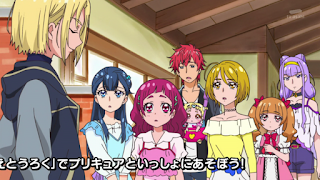
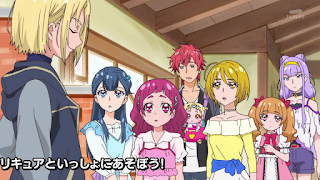
In episode 19 of Hugtto! PreCure, Henri invites the girls to attend a fashion show. This is quite an interesting episode, as it touches upon a subject that hasn’t really been brought up before within PreCure if I recall correctly.
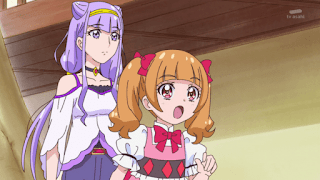
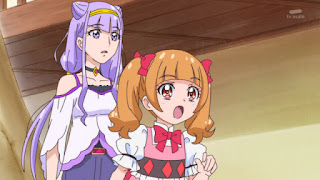
Henri wants Lulu and Emiru to perform at a fashion show
At the end of the previous episode, Henri heard the song that Lulu and Emiru performed together. He decided to ask them to perform their duet at a fashion show.
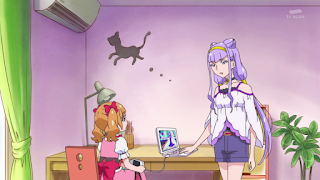
As usual, Lulu has rapidly memorised what she needs to know by heart -this time, how to walk a runway!-.
Henri approached the girls and wants Lulu and Emiru to participate in the Fashion Runway which Emiru was worried that she might mess up (She thinks she will roll out of the stage and end up in Paris, which Lulu explained is impossible) and Lulu took the role for Emiru's sake.
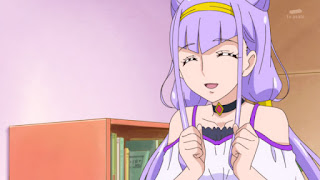
Lulu cheers Emiru on
Emiru is very nervous about the whole thing, but Lulu is there to reassure her. She even tells Emiru that she will be cheering her on.
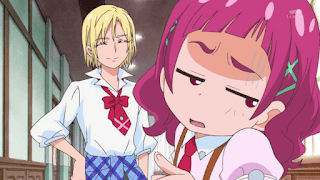
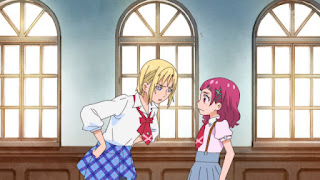
Henri at school - notice that smart uniform... and are those shorts or a skirt?
(You'll find out soon why this rhetorical question!)
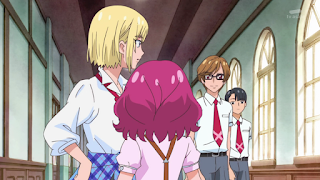
Their conversation is cut short by the arrival of Emiru’s brother, who takes issue with the way Henri is dressed – he is dressed like a girl. Henri decides to just leave it.
During the episode, Emiru's brother Masato, who is also a student in the same school as the girls, mocked Henri who was wearing differently in his school uniform. Of course, Henri took it cool and ignored his taunting.
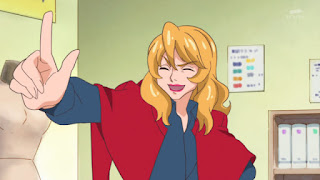
Fashion designer Rita Yoshimi
It turns out the fashion designer that the girls (and Henri) will be working with is Rita Yoshimi. We have seen her appear a couple of times before – the villains used her negative emotions as the catalyst of the week in a couple of the previous episodes.
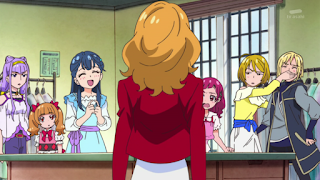
Henri almost reveals that the others are PreCures, but Homare quickly shuts him up whilst Saaya saves the situation by saying they are fans. Rita is a PreCure fan herself – in fact, it seems that she was even inspired by them for her latest range.
The girls get to work - Bohemian artists
As promised, the others help Rita to prepare for the fashion show. They start painting, and even Hugtan joins them.
Hugtan helps as well
Hugtan uses the paint to make handprints, which turn out like flowers.
![]()
The other girls do the same, and even Lulu and Emiru join them as well.
![]()
Emiru gets a handprint on the right cheek...
![]()
...and Lulu gets the matching print on the left.
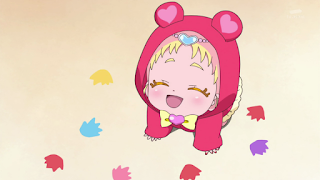
The other girls do the same, and even Lulu and Emiru join them as well.

Emiru gets a handprint on the right cheek...
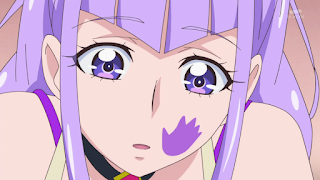
...and Lulu gets the matching print on the left.
I get the distinct feeling that these colours will be very important for these two in the near future…
Everything is prepared in time, and both Lulu and Emiru mentally prepare themselves for the show. Emiru’s brother Masato does some research on what Emiru will be doing. When the day of the show arrives, Emiru is quite nervous.
Lulu hugs Emiru to reassure her
Emiru may be nervous, but Lulu is there to assure her that they can do anything if they are together. This touching moment is soon interrupted by the arrival of Emiru’s brother, who tries to take her back home. According to Masato Aizaki, girls can’t be heroes – girls should be the ones being protected.
Lulu tries to say something, but she remembers Papple saying that she couldn’t be a hero before.
Lulu tries to say something, but she remembers Papple saying that she couldn’t be a hero before.
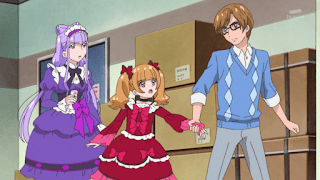
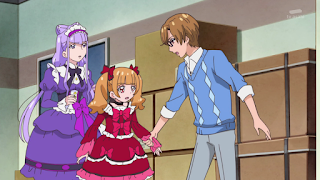
MASATO: Let's get out of here, Emi. This is no place for you...
Later Masato learned that Emiru is entering the fashion show and tried to take her away claiming that only girls shouldn't be heroes, but Henri who wore a dress, a wedding gown for more information, appeared and claimed that anyone is free to do whatever they want to and should not be restricted.
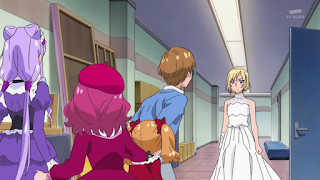
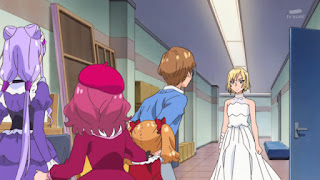
Henri confronts Emiru’s brother
Henri also happened to overheard what Emiru’s brother said, so he puts on the dress that Rita designed for him and steps out to confront him. He says that living with restrictions is a waste of life, and just walks off with the others. Needless to say, Emiru’s brother is not very happy after that.
HENRI: I am a queen, so what? We are free to wear whatever we please. Living with restrictions is a waste of life...

A new villain/cadre appears
With Emiru’s brother being in a bad mood, he has plenty of toge-power. A new female villain or cadre jumps upon the opportunity, and uses him to summon a very Masato-like theender.
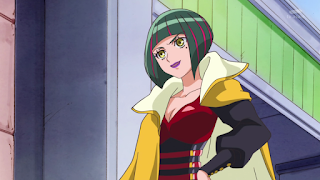
She just loves the taste of fresh bigotry in the morning, doesn't she?
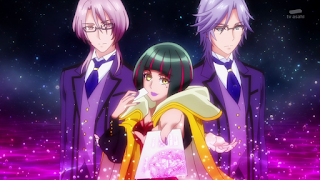
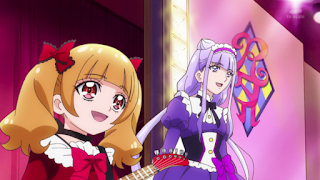
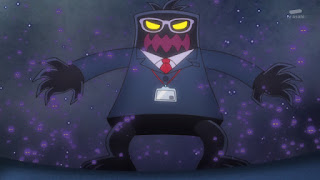
Here’s this week’s theender
Just as the fashion show begins, the bespectacled theender in a suit attacks; the others transform to take it on, but the incredible amount of toge-power it has makes it a formidable opponent.
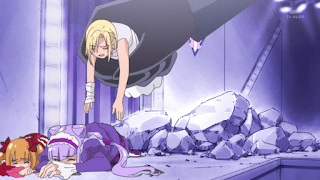
Henri saves Lulu and Emiru from some rubble falling from the ceiling, and then the theender grabs him, King Kong style. He leaves up to the heroes to save the "damsel."
As PreCures fight the theender, Henri sees that it's Emiru’s brother. Henri comes to a realisation about the monster, and breaks out of its grip.
Henri hugs theender!Masato
This of course pissed Masato off and was turned by the new general, Gelos, into a theender. As theender!Henri wrecking the place and holding Henri hostage, he spotted Masato as the host and felt his pain which somehow create an opening for the girls to defeat it.
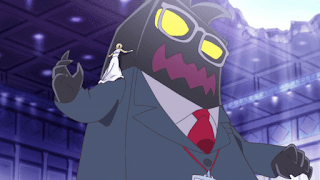
Henri tells theender!Masato that he has no intention of changing himself for anyone. The monster grabs him again, but Henri continues to say that his life his is own and that he cherishes his own heart.
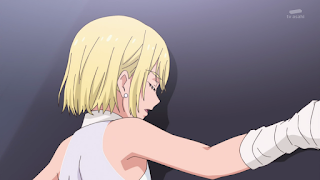
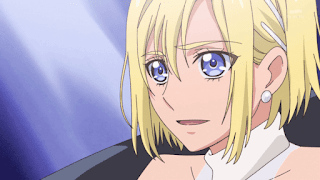
He also says that Emiru’s brother could learn to love his own heart a little as well. These words seem to resonate with Lulu.
Theender!Masato throws Henri aside, but Cure Yell catches him. PreCures then take the opportunity to defeat the monster.
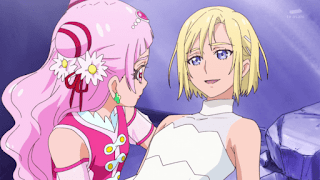
With it gone, the new female villain takes a moment to introduce herself.
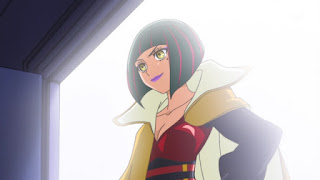
Gelos
Her name is Gelos. Lulu doesn’t recognise her, but it is clear that she works for Cryasse.
The fashion show goes ahead after that. It is successful, and Emiru’s brother even mentions that he had a dream. He called it the worst, but also beautiful.
In the end, Masato felt different after seeing Henri onstage...
In the end, Masato felt different after seeing Henri onstage...
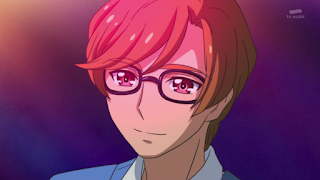
(Maybe, no, most surely he's queer himself but ashamed, due to the rank and expectations thrust upon him...)
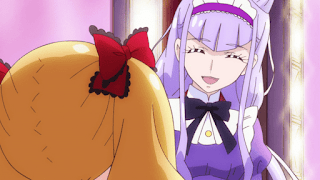

After the show, Emiru says that she wants to become a PreCure together with Lulu.
“Futari wa PreCure” – that also happens to be the title of the first ever season of PreCure
I absolutely adore these episodes that have been focusing on Lulu and Emiru, and this episode has been no exception to that particular.
Definitely have to give major props to Henri, too. As far as I remember, PreCure has never really featured a character like him before, and I would say that it is a really positive thing that he is part of this season.
It’s stuff like this that will make the world a more tolerant place, I think. This season of PreCure definitely has some really good messages to it.
Definitely have to give major props to Henri, too. As far as I remember, PreCure has never really featured a character like him before, and I would say that it is a really positive thing that he is part of this season.
It’s stuff like this that will make the world a more tolerant place, I think. This season of PreCure definitely has some really good messages to it.
Henri was certainly played a major role in this episode, but it is Lulu and Emiru that stole the show for me – again. Those two are just incredibly good together, and it warms my heart a lot to see them simply interacting with each other.
I could probably go on and on about how amazing Lulu and Emiru are, but I’m sure there will be plenty more opportunities to do that with future episodes.
I could probably go on and on about how amazing Lulu and Emiru are, but I’m sure there will be plenty more opportunities to do that with future episodes.
Next time, something happens that I have eagerly been awaiting ever since the introduction of Lulu. WOT WOT WOT THE... SHE BECOMES A PRECURE, DON'T TELL ME...? And not only she, but Emiru as well... :O <3 <3 <3 <3 <3
I enjoyed this episode! Ever since Henri stopped being an obnoxious prick, like Emiru I have grown to like him more and more. In fact, I would say Henri was the highlight of the episode. I absolutely loved seeing him confidently own who he is, even when he is mocked. When it comes to boys wearing girls clothes or resembling girl’s fashion, it is a controversial subject just about everywhere. I was rooting for Henri because it takes an incredible amount of courage to be different in a world where society judges you based on appearance. His speech about how he won’t change himself for others, he will cherish his own heart was an empowering message.
I said it before, and I’ll say it again, I think it would be amazing if Henri were to become a precure too. The moment he recognized Emiru’s brother was hurting, and did the
…But it might end up creating a contradiction/mixed messages when this episode wanted to highlight how girls can be heroes too! They initiated a reversal of roles, where Henri, the boy, was the “princess” who had to be rescued (not only he owned it, but he did some incredible stuff on his own, which only makes me want him to become a precure even more), and the girls were his knights coming to his rescue. So making Henri a precure might not fit, but then again, one has to wonder what about the little boys want to be a precure too? I am sure there are! This kind of message, while it is incredibly important for girls to hear, holds just as much value for the boys. It is a universal message of encouragement to everyone who are daring to be different than what society expects of them.
What is a bit strange to me is how we didn’t get to see the girls have a quick conversation with Henri how the fact they are precures must be kept a secret. He already figured it out, but didn’t realize that it’s not something they want to announce to the world. Of course with time restraint, there may have not been enough time to do so, but I would like to see the group actually have a conversation with him about it, eventually… Preferably sooner than later, which would give him the privilege to be part of their inner circle, should he desire to.
Another thing I noticed was how the main trio has been more or less benched in the last two episodes, next week is looking to be the third as both Emiru and Lulu will become precures (honestly I’m surprised they spoiled it). Of course, most of us already knew it was going to happen, not matter what, but they did throw us a little twist by raining on the girls’ parade, revealing there’s only one preheart left. Either a new one will be magically produced through Hugtan’s power (which I am suspecting is how it happens in the first place, since she will need her own if she grows up), or the girls will end up sharing one, which would be pretty symbolic given the friendship that has been formed between them.
Emiru’s brother my god, he is unbearable. This sexist douche is back again, this time as a queerphobic douche, this time it was Henri who shut him up. I was deeply disappointed to see Lulu had lost that fire in her, the one who confronted him when he said girls shouldn’t play guitars. I loved that part of her, and it sucks that it is gone. I hope she will be able to rediscover it, because while I adore the cute and adorable Lulu, I am missing her savage and fierce side as well. Anyhow, thanks to this experience becoming a theender, it might help open his mind, making it the last time we have to see him act like this.
Lastly, let’s take a moment to talk about our new villains! Okay, so only one showed up today, the new villainess Gelos had an interesting way of making an entrance, by only doing so after she was defeated. It looks like she may actually be part of a trio, since during her negative wave sequence, it featured not just her, but the other two men, who looks like twins and are probably her butlers or something. But damnnnnnnnnnnnnn~ they are good looking! All three of their character designs, on point!*swoons* I can’t wait to see them in action.
However, it may have slipped under people’s noses, but the white dove made two apeparences. The first time with George, exchanging messages, and sending a new one, and the second time, was when Gelos made her debut. This leaves me with the impression that is was George/Papple’s Unrequited Love who recruited her to come, as Lulu has no recollection of Gelos working at Cryasse. Also I don’t really get what they keep on hiding the guy’s face, I am pretty sure it’s George, unless it’s supposed to be his twin or counterpart or something…. I mean, they dress the same for crying out loud… Eh whatever, if it’s not him, I will correct myself later.
We got a closer peek at this new cadre and... ON POINT. SPOT ON. BONUS FOR THE BEAUTY MARK, AND FOR ONE FLOOZY ON EACH ARM. When Papple was complaing to the mystery man (which is probably George), he sent a note using a homing pigeon which, when Gelos later turned Masato into a theender, a flock of pigeons appeared followed by slendermen (What!?) and cool looking ikemen butlers. (Double what!?)
Lolita fashion and why I love it:
Henri vs. Masato: I totally expected that vitriol between the two of them (secretly shipping them, although I know this is an unrequited affair and Gods know what the scriptwriters have in store). The climax was when Masato was angry over Henri telling him off for choosing to crossdress on the runway, and Gelos (the new cadre, the lady with the beauty mark and the bob haircut), making the Aizaki scion, due to his negative emotions (queerphobia, this time) into the theender of the week, which not only wears Masato's own spectacles and suit, but promptly King-Kongs a crossdressing Henri into being a gentleman in jeopardy for the Cures to rescue.
June happens to be Pride Month here in Spain, so a coming out episode like this was definitely spot-on and a positive surprise.
Henri en travesti: The fact that a bishie has to don a dress with a long skirt in this episode, and furthermore that he comes out,
Closet Gay Masato theory:
How surprised I was that Emiru had stage fright: as much as about Henri's equally unexpected passion for crossdressing!
Emilu as an OTP (runway, final smiles): We got a lot of vivid Emilu moments today. We saw them get messy with paint, and they got matching marks in their respective signature colours on the right and left cheekbones, respectively (Symbolism!).


We saw Lulu hug Emi for reassurance right before they trod the runway. We saw Emilu huddle together for cover as Henri saved them from being buried alive. And of course their heartwarming duet on the runway. Long story short: we saw our OTP for this series getting canonised.

Emilu about to become Cures: Emiru and Lulu decided to take their steps to become Precures and told the girls their goal however Harry breaks out the news that there is only one Preheart device and there are two of them! Everyone looked at each other puzzled although Hug-tan was "encouraging" Emiru and Lulu to be "together..." Yes, the baby is shipping them on deck and all! And remembering their handprints on the left and right halves... From the mouths of babies...
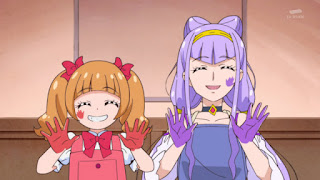
What I think is the most likely scenario when Preheart time comes is that the single original transformation trinket will break in twain. Lulu will have the left half (lilac), while Emiru will have the right half (red). As foreshadowed by their handprints in this episode. And they will have to join the halves of the broken crystal or perform another similar motion to transform.
This episode is more of a set-up for the next few episodes since it is really about Emiru and Lulu taking their first steps to becoming Precures and the introduction of Gelos.

Henri stole the show since he was able to counter Masato's insults and yes, Masato is a still a jerk especially about his remarks on Henri's uniform and how only males should be heroes. But Masato also mentioned about his and Emiru's grandfather which might be the reason for his upbringing. Who know, maybe we will get an episode to find out about the staunch Aizaki patriarch in the future.
The white birdy (dove?) of Cryasse: Maybe, like in Mystery Incorporated or Pichi Pichi Pitch Pure, the birdy isthe mastermind. All along. Just a theory based on the cast of those two shows, but let's see if, like the Defector from Decadence Harry theory, it is confirmed by Word of Izumi.
NEXT EPISODE (20):
The white birdy (dove?) of Cryasse: Maybe, like in Mystery Incorporated or Pichi Pichi Pitch Pure, the birdy isthe mastermind. All along. Just a theory based on the cast of those two shows, but let's see if, like the Defector from Decadence Harry theory, it is confirmed by Word of Izumi.
NEXT EPISODE (20):
Anyway, the more pressing problem is how will Emiru and Lulu become Precures if there is only one Preheart device? Will it be the end of their dreams? Or like what Hug-tan saying "Together" could led to a clue? As the next episode title preview-we are getting not one but two new Cures at the same time! Until then, see you in the next post!
What I think is the most likely scenario when Preheart time comes is that the single original transformation trinket will break in twain. Lulu will have the left half (lilac), while Emiru will have the right half (red). As foreshadowed by their handprints in this episode. And they will have to join the halves of the broken crystal or perform another similar motion to transform.
































































































 There is no doubt in my mind that George is the big bad. He subtly highlighted his scary side, and it was enough for both Harry and Hugtan to recognize something was amiss. If Hugtan drops her smile, you know something is wrong. Now that he has encountered her in person, it makes me wonder if this will influence how Cryasse will operate from here on out. Originally they were targeting the future crystals, and were working to defeat the precures, but it feels like if anything, George was able to confirm his suspicions, and we may see the enemy start to specifically target Hugtan— who that is undoubtedly far easier to find and obtain.
There is no doubt in my mind that George is the big bad. He subtly highlighted his scary side, and it was enough for both Harry and Hugtan to recognize something was amiss. If Hugtan drops her smile, you know something is wrong. Now that he has encountered her in person, it makes me wonder if this will influence how Cryasse will operate from here on out. Originally they were targeting the future crystals, and were working to defeat the precures, but it feels like if anything, George was able to confirm his suspicions, and we may see the enemy start to specifically target Hugtan— who that is undoubtedly far easier to find and obtain.




















































































































